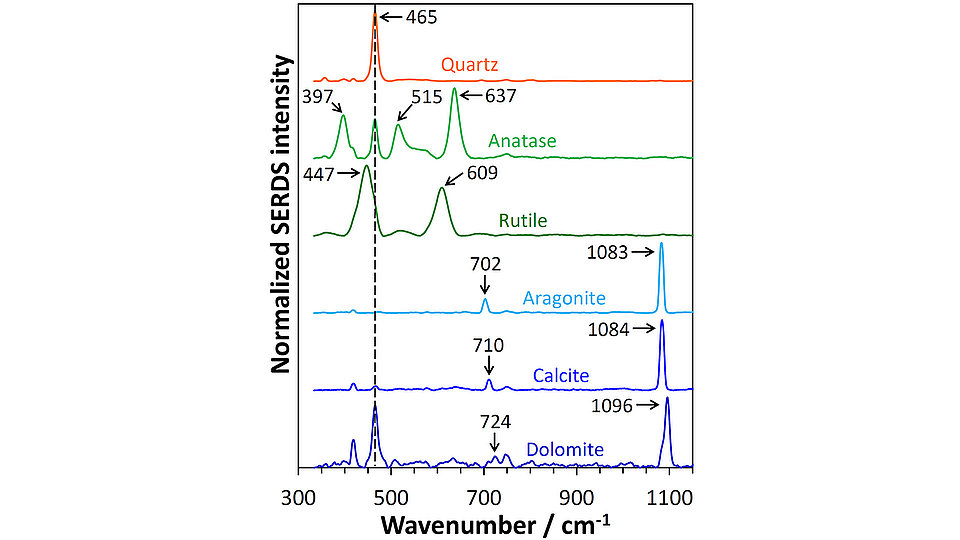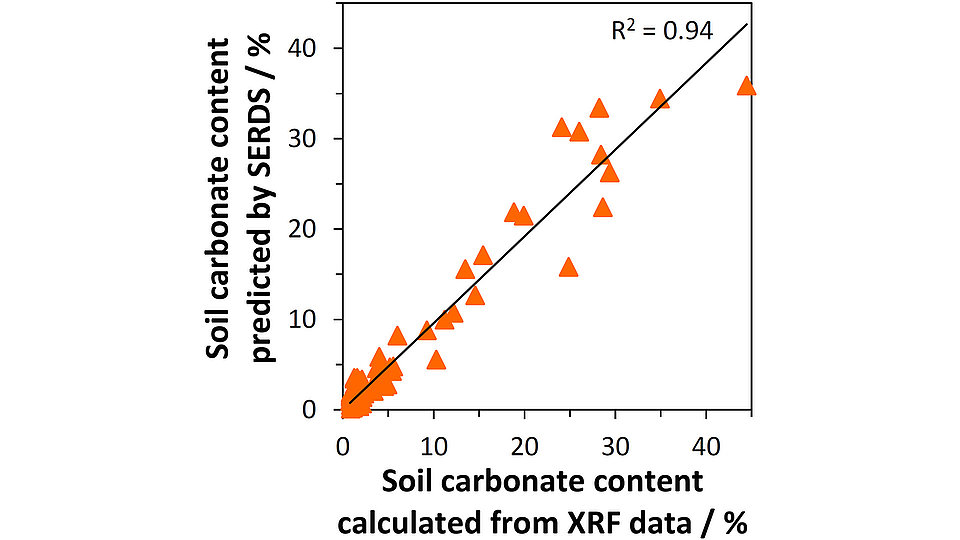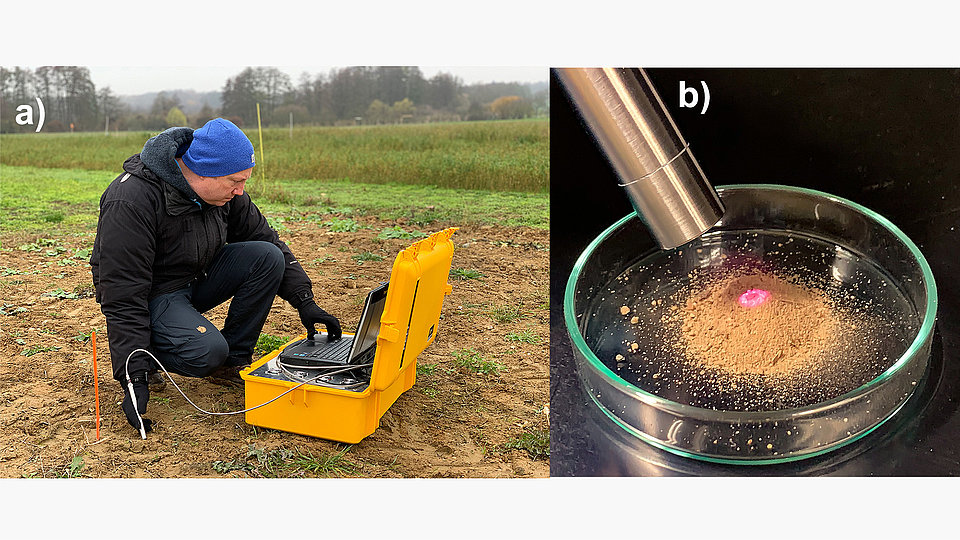Shifted excitation Raman difference spectroscopy identifies soil minerals and predicts soil carbonate content
Fig. 1: Average of 10 single Raman spectra (top curves) excited at 785.2 nm and 784.6 nm, and SERDS spectrum (bottom curve) obtained from one selected soil sample.
Fig. 2: Representative SERDS spectra of selected soil minerals identified within a set of 117 specimens. Dashed vertical line indicates major Raman signal position of quartz. Spectra are vertically offset for clarity.
Fig. 3: Carbonate content predicted from SERDS spectra of 117 soil samples applying partial least squares regression plotted in dependence of soil carbonate content calculated from elemental calcium content measured by X-ray fluorescence (XRF) reference analysis.
To improve crop productivity, increase soil health and reduce excessive fertilizer usage the concept of precision agriculture is gaining importance worldwide. In situ sensing methods can provide the necessary data input for on-site decision support systems to identify and address fertilization and irrigation demands. Raman spectroscopy is a well-established and powerful technique that can assess the molecular composition of soil. One major challenge is laser-induced fluorescence originating from soil organic matter and clay minerals that can easily mask Raman spectroscopic information. To address this issue, we selected the shifted excitation Raman difference spectroscopy (SERDS) method as it permits to separate Raman signals effectively from fluorescence interference. Our previous investigations have shown that mineral and organic components can be detected and identified in this way [1,2]. The technique applies a physical approach with two slightly shifted laser wavelengths. For this purpose, FBH has designed and developed specialized 785 nm dual-wavelength diode lasers for SERDS.
The fluorescence issue is depicted in Fig. 1 (top) where Raman spectra of a soil sample excited at 785.2 nm and 784.6 nm using a laboratory setup do not permit to observe characteristic Raman signals of soil components. In the reconstructed SERDS spectrum displayed in Fig. 1 (bottom), however, selected Raman signals of soil minerals can be identified. Besides quartz (signal at 465 cm-1) as main component of many soils also the titanium dioxide modification anatase (signals at 397 cm-1, 515 cm-1 and 637 cm-1) and the calcium carbonate form calcite (signal at 1084 cm-1) are present in the soil sample.
Comprehensive soil investigations with SERDS demonstrate capability for qualitative and quantitative soil analysis
Besides fluorescence, the intrinsic soil heterogeneity imposes a further challenge. To consider this important point, systematic SERDS laboratory investigations were performed on a set of 117 soil samples collected from an agricultural field in Germany close to Frankfurt/Oder (52.39N; 14.46E). In total, 13 mineral soil components could be identified including silicates (quartz, Na-feldspar, K-feldspar, spessartine, almandine, zircon and diopside), hydroxyapatite, titanium dioxides (anatase and rutile) and carbonates (aragonite, calcite and dolomite). Representative SERDS spectra showing the most prominent contributions of individual soil components are exemplarily displayed in Fig. 2. The unique molecular fingerprint of all substances permits to distinguish also polymorphs of titanium dioxide (anatase, rutile) and calcium carbonate (aragonite, calcite), i.e. components with the same chemical formula but a different crystal structure.
Carbonate content is an important soil parameter with implications for liming requirements as well as binding of nutrients, e.g. phosphates. X-ray fluorescence (XRF) is an established method to measure soil elemental contents, e.g. the calcium content, but the method is unable to determine the molecular binding form of the calcium. In contrast, our SERDS investigation has shown that calcite is the only calcium-containing molecular species that is present in significant amounts within the probed soil samples. Using this additional information, it is then possible to calculate a reference carbonate content from the elemental calcium content measured by XRF. A partial least squares regression of the SERDS spectra against the XRF data shows a very good linear correlation with a coefficient of determination of R2 = 0.94 (see Fig. 3).
The outcomes of our study demonstrate the capability of SERDS for qualitative (identification of soil minerals) and quantitative (prediction of carbonate content) soil analysis [3]. SERDS has thus a great potential for soil inspection in the context of precision agriculture but also in other application areas including geology, cultural heritage or planetary exploration. To translate the technique from the laboratory to the field, a portable SERDS system developed by FBH’s Prototype Engineering Lab was recently tested in an on-site pilot experiment (see Fig. 4) [4].
This work was funded by the Federal Ministry of Education and Research (BMBF) through the funding measure BonaRes (Soil as a Sustainable Resource for the Bioeconomy) in the project RaMBo (Raman-Messsystem zur ortsspezifischen Bodenanalytik) within the consortium I4S (Intelligence for Soil) under grant numbers 031A564C and 031B0513C.
Publications
[1] L. S. Theurer, M. Maiwald, B. Sumpf, “Shifted excitation Raman difference spectroscopy: A promising tool for the investigation of soil”, European Journal of Soil Science, vol. 72, no. 1, pp. 120-124 (2021).
[2] K. Sowoidnich, S. Vogel, M. Maiwald, B. Sumpf, “Determination of soil constituents using shifted excitation Raman difference spectroscopy”, Applied Spectroscopy, vol. 76, no. 6, pp. 712-722 (2022).
[3] K. Sowoidnich, M. Maiwald, M. Ostermann, B. Sumpf, “Shifted excitation Raman difference spectroscopy for soil component identification and soil carbonate determination in the presence of strong fluorescence interference”, Journal of Raman Spectroscopy, doi: 10.1002/jrs.6500 (2023).
[4] M. Maiwald, K. Sowoidnich, B. Sumpf, "Portable shifted excitation Raman difference spectroscopy for on-site soil analysis", Journal of Raman Spectroscopy, vol. 53, no. 9, pp. 1560-1570 (2022).
![[Translate to English:] Graph showing average of 10 single Raman spectra (top curves) excited at 785.2 nm and 784.6 nm, and SERDS spectrum (bottom curve) obtained from one selected soil sample.](/fileadmin/_processed_/0/2/csm_SERDS-Fig2_fbc43f878a.jpg)


